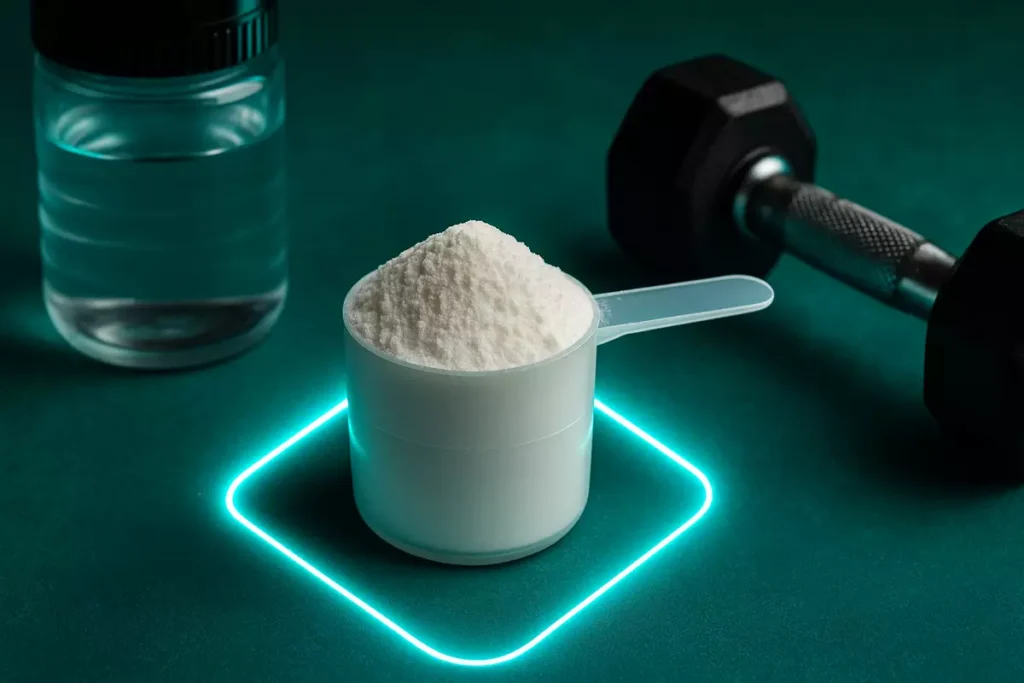Creatine is one of the most trusted supplements for athletes. But when it comes to creatine ethyl ester vs creatine monohydrate, which one really delivers results?
Marketers claim ethyl ester absorbs better, while science consistently favors monohydrate.
As a fitness trainer who has tested both and coached athletes worldwide, I’ll share the truth, the research, and real-life results you can rely on.
Table of contents
Which Is Better for Athletes?
If you’re an athlete looking to boost strength, recovery, and muscle growth, creatine monohydrate is the clear winner.
Research consistently proves it raises muscle creatine levels, improves performance, and supports long-term progress.
Creatine ethyl ester (CEE), despite flashy marketing, breaks down faster into creatinine and delivers fewer results.
In my own experience and through my clients, monohydrate always outperforms CEE.
👉 Related: Best Creatine Types for Rapid Muscle Recovery
What Is Creatine Monohydrate?

Creatine monohydrate is the most researched supplement in sports nutrition.
It increases phosphocreatine stores in your muscles, allowing you to regenerate ATP—the main fuel for high-intensity exercise.
When I first started using creatine monohydrate, I felt a difference within two weeks. My bench press jumped by 7 kilos, and I recovered faster between sets.
The only change in my appearance was mild water retention, but it actually made my muscles look fuller, which I enjoyed.
One of my clients, David from Germany, saw similar results. After six weeks, his squat strength increased by 15%, and his recovery improved noticeably.
👉 Read more: Creatine Monohydrate and Testosterone – The Real Link
What Is Creatine Ethyl Ester (CEE)?
CEE was marketed as a “better” creatine with improved absorption and no bloating.
The truth? Studies show it converts into creatinine (a waste product) much faster than monohydrate. That means your muscles don’t actually get the benefits.
I learned this the hard way. In my early bodybuilding years, I tried CEE for a couple of months. Nothing changed—no strength gains, no recovery boost, nothing at all.
One of my clients, Ana from Brazil, had the same experience. She used CEE for weeks without progress. Once she switched to monohydrate, she noticed better recovery and strength within three weeks.
👉 You may also like: Vegan Creatine vs Monohydrate
Key Differences Between CEE and Monohydrate

- Absorption & Effectiveness: Monohydrate raises muscle creatine levels significantly. CEE does not.
- Performance Outcomes: Monohydrate supports strength, sprinting, recovery, and muscle growth. CEE fails to deliver consistently.
- Cost & Availability: Monohydrate is cheap, reliable, and available worldwide. CEE is often overpriced with little return.
From my own trials, monohydrate gave me fuller muscles, better pumps, and obvious performance gains.
CEE felt like wasted money.
👉 Related: Loading vs. No Loading – Creatine Results Explained
Side Effects & Safety
Creatine monohydrate has been studied for decades and is safe when taken at 3–5 grams per day.
Some worry about kidney health, but this is a myth not backed by science.
I’ve had clients like Omar from Egypt avoid creatine for years because of this fear. When he finally tried monohydrate, he not only stayed healthy but also gained strength and faster recovery.
CEE, on the other hand, can sometimes cause stomach discomfort—and without real benefits, it’s hard to justify.
Kenji from Japan once told me he felt bloated on CEE but never had issues with monohydrate.
👉 Learn more: Creatine Monohydrate Bloating and Cramps – Guide
Practical Recommendation for Athletes

If your goal is performance, recovery, and maintaining muscle during tough training phases, monohydrate is the best choice.
I recommend 5 grams daily, preferably after your workout with a protein shake or meal. Personally, I use it year-round without cycling. The consistent benefits are too valuable to skip.
During fat-loss phases, creatine helps protect strength levels even with lower calories. Marta from Italy was able to push harder in cardio sessions and maintain muscle mass while dieting thanks to monohydrate.
👉 Also read: EAAs + Creatine Pre-Workout Combo Guide
Final Takeaway
The bottom line is simple: Creatine monohydrate is the gold standard.
It’s backed by decades of research, trusted by athletes worldwide, and proven in my coaching experience.
CEE, on the other hand, is mostly marketing hype. Sophie from Canada switched from CEE to monohydrate, and within a month, her squat went up by 10 kilos. She also recovered so well that she could train an extra day per week.
That’s the difference between hype and results.
👉 Related: Is Creatine Monohydrate Banned in Sports?
So if you want real results, skip the hype. Stick with the supplement that science—and countless athletes—already trust: creatine monohydrate.



Leave a Reply